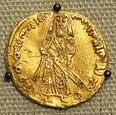
Gold Dinar with image of standing Caliph, ca. 695 AD Courtesy of the British Museum
Originally posted on Thursday, February 20th, 2014
Currency War?
Financier and author James G. Rickards wrote a 2012 best selling book, Currency Wars: The Making of the Next Global Crisis. Politico‘s Mike Allen described it as “One of the most urgent books of the fall.” Rickards wrote:
“[T]he lab’s Warfare Analysis Laboratory, [is] one of the leading venues for war games and strategic planning in the country. … It was for this purpose, the conduct of a war game sponsored by the Pentagon, that about sixty experts from the military, intelligence, and academic communities arrived at APL on a rainy morning in the late winter of 2009. … [T[he only weapons allowed would be financial — currencies, stocks, bonds, and derivatives. The Pentagon was about to launch a global financial war using currencies and capital markets instead of ships and planes?”
Rickards’ projected currency war would not be the first such in history.
Muslimheritage.com teaches:
As part of his policy to unify the various regions under Islamic rule, Abd al-Malik ibn Marwan (685-705CE) introduced the first Umayyad gold coins at a time of discord between the Umayyads and Byzantines over the merits of Islam and Christianity. The early coins were struck either in 691 or 692; the Byzantine emperor was angry and refused to accept the new Arab gold currency, renewing the war between the Arabs and the Byzantines.
The new Islamic currency that was first coin to carry an Arabic inscription…. On… the reverse, the Byzantine cross was replaced by a column placed on three steps topped with a sphere. In the margin surrounding the design the testimony of Islam was written in Arabic: “In the name of God, there is no deity but God; He is One; Muhammad is the messenger of God.”
The Byzantine emperor Justinian II responded to this challenge by striking a new solidus with the head of Christ on the obverse and on the reverse an image of himself robed and holding a cross.
Caliph Abd al-Malik’s response was to issue a new dinar in 693. … Once more, the Byzantine emperor responded by striking a new coin similar to that of the Arabs, which greatly displeased Abd al-Malik. … After he introduced this coin, Abd al-Malik issued a decree making it the only currency to be used throughout Umayyad lands. All remaining Byzantine and Arab-Byzantine pieces were to be handed to the treasury, to be melted down and re-struck. Those who did not comply faced the death penalty.
“[T]he Byzantine emperor was angry and refused to accept the new Arab gold currency, renewing the war between the Arabs and the Byzantines.” History shows that the first actual currency war took place over a thousand years ago. Will there ever be another?
Only time will tell.

Recent Comments